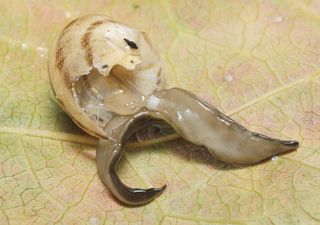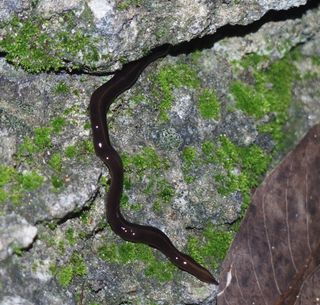Alien-Like Worm Invades US

A bizarre invasive worm with its mouth in the middle of its belly has been found in the United States for the first time, according to new research.
The New Guinea flatworm (Platydemus manokwari) is only a couple of millimeters thick but grows to be up to 2.5 inches (65 millimeters) long. As its name suggests, the worm is a New Guinea native, but it has been spreading across the globe, hitching rides on exotic plants and in soil. The worm wraps itself around snails and ingests them with a mouthlike structure on its underside. As an invasive species, it's a threat to native snails — so much so that the Invasive Species Specialist Group of the International Union for Conservation of Nature (IUCN) lists it among the 100 worst invasive species in the world.
The flatworm had previously been detected in the wild in 15 countries, as well as in a greenhouse in France, but this is the first time it's been found in North America. A multinational group of researchers, led by scientists at the Muséum National d'Histoire Naturelle in France, combed through flatworm specimens and photographs collected by locals around the world. [See Photos of Bizarre Flatworm & Other Destructive Invasive Species]
Spreading threat
The researchers discovered P. manokwari in five countries and territories where it had never been reported before: New Caledonia, a small collection of islands in the southwest Pacific; Singapore; the Solomon Islands, also in the southwest Pacific; Puerto Rico; and Florida.

The introduction of the species appeared to be recent in many of these cases. The worm probably arrived in Florida in or around 2012, the researchers reported in the open-access journal PeerJ. Since then, it seems to have established itself and can now be found in multiple places in Miami-Dade County.
In Puerto Rico, the worm showed up in San Juan, the capital, in 2014. The first discovery of the worm in the Solomon Islands also occurred in 2014, on Guadalcanal.
Sign up for the Live Science daily newsletter now
Get the world’s most fascinating discoveries delivered straight to your inbox.
Wormy genetics
The researchers also discovered two genetic groups, or haplotypes, of the worm. These two groups are virtually indistinguishable except on the level of their genetic codes. One, dubbed the "Australian haplotype," was found only in Australia and the Solomon Islands. The other, dubbed the "World haplotype," has been found in France, New Caledonia, French Polynesia, Singapore, the Solomon Islands and Puerto Rico. The specimens found in Florida also belonged to this World haplotype.
The genetic findings suggest that both haplotypes of worm exist in their native New Guinea, but that for unknown reasons, only the World haplotype has spread significantly, the researchers wrote.
The discovery of the flatworm in the United States is particularly concerning because the flatworm had previously been confined mostly to small islands, they added. From Florida, however, P. manokwari could easily spread to the rest of the United States and the Americas.
Follow Stephanie Pappas on Twitter and Google+. Follow us @livescience, Facebook & Google+. Original article on Live Science.

Stephanie Pappas is a contributing writer for Live Science, covering topics ranging from geoscience to archaeology to the human brain and behavior. She was previously a senior writer for Live Science but is now a freelancer based in Denver, Colorado, and regularly contributes to Scientific American and The Monitor, the monthly magazine of the American Psychological Association. Stephanie received a bachelor's degree in psychology from the University of South Carolina and a graduate certificate in science communication from the University of California, Santa Cruz.
Most Popular

